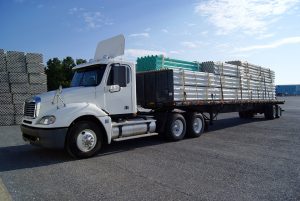
Securing freight on a flatbed properly is essential for safety.
One of the essential tasks of responsible trucking is tying down loads securely. Whether you are shipping cargo on a semi or a flatbed truck, proper loading is vital to both preserving the load and keeping people on the road safe. The one principle to keep in mind when tying down loads on trucks is to make the load one unit with the load carrier, having no longitudinal, sideways, or vertical movement. Below are common ways to tie down loads on trucks securely.
Blocking
Blocking is a highly secure way of tying down loads on trucks of any kind. Whether you are dealing with a flatbed, a step-down, or a semi-truck, it is possible to secure your freight with this method. Blocking is securing freight on the truck to the nearest immovable structure, such as the headboard or the sideboard. One might use metal, rectangular columns vertically or horizontally along the perimeter of compact cargo. One cannot usually achieve blocking without leaving minimal gaps, but one can stuff the gaps with a filler material if necessary.
Locking
On a flatbed truck, one might have the convenience of locking cargo onto the truck through built-in mechanisms within the chassis. These locks can rise up and turn to lock cargo into place. One should probably use locking in tandem with other load securing methods.
Lashing
Lashing comes in various forms, but the main principle is to tie down a load on a truck with lashing belts, metal wires, or chains. The lashing should only connect with the freight itself and one attaching point on the truck, and each attachment point should only have one lashing connected to it. One can use one or more lashing methods at once to achieve a truly safe load.
Frictional lashing is one major type of lashing and is best demonstrated through the top-over method. Top-over lashing ties down cargo with vertical pressure, attaching on either side of the flatbed. This method works best when the cargo itself forms 90-degree angles.
Meanwhile, direct lashing is the other major type, which encompasses the three methods below:
- Loop lashing: Loop lashing is useful when the load has a place around which the lashing belt, chain, or wire can loop around and secure to the load carrier. One will need to use them in pairs for equal security on both sides.
- Spring lashing: Spring lashing does not necessarily attach to the load carrier, but crosses around it to secure the load to itself.
- Straight lashing: Straight lashing prevents longitudinal shifting, but should be used with other ways to tie down a truckload.
For All Your Trucking Needs
Follow us here at Evan Transportation to get more updates on driving tips and the trucking industry. Evan Transportation provides trucking and transportation services for clients throughout the Mid-Atlantic region. All of our drivers and staff are offered competitive salaries, benefits, and are guaranteed to be home every day. Interested in finding out more? Visit us online or give us a call at 443-673-3365. For even more information, visit us on Facebook, Twitter, Pinterest, and LinkedIn.
